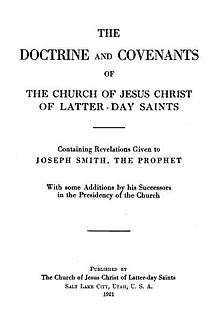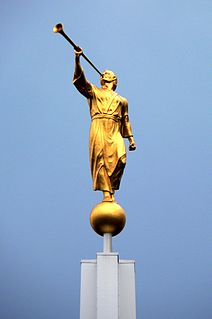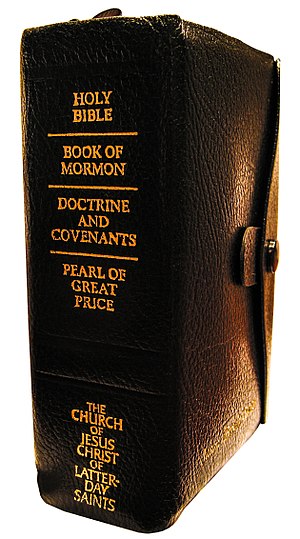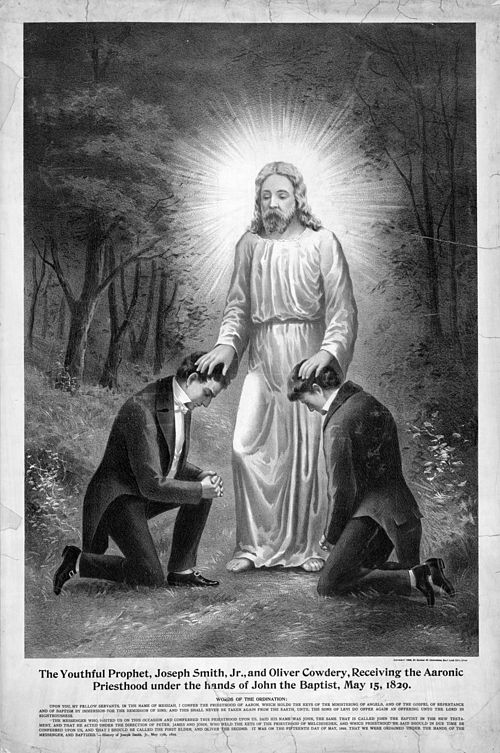
The standard works of The Church of Jesus Christ of Latter-day Saints are the four books that currently constitute its open scriptural canon. The four books of the standard works are:

The Doctrine and Covenants is a part of the open scriptural canon of several denominations of the Latter Day Saint movement. Originally published in 1835 as Doctrine and Covenants of the Church of the Latter Day Saints: Carefully Selected from the Revelations of God, editions of the book continue to be printed mainly by The Church of Jesus Christ of Latter-day Saints and the Community of Christ.

Mormonism is the predominant religious tradition of the Latter Day Saint movement of Restorationist Christianity started by Joseph Smith in Western New York in the 1820s and 30s.
In the Latter Day Saint movement, the restoration refers to a return to the earth of the authentic priesthood power, spiritual gifts, ordinances, living prophets and revelation of the primitive Church of Christ after a long period of apostasy. While in some contexts the term may also refer to the early history of the Latter-day Saint religion, in other contexts the term is used in a way to include the time that has elapsed from the church's earliest beginnings until the present day. Especially in The Church of Jesus Christ of Latter-day Saints "the restoration" is often used also as a term to encompass the corpus of religious messages from its general leaders down to the present.

The Book of Abraham is a work produced between 1835 and 1842 by Joseph Smith based, he said, on Egyptian papyri purchased from a traveling mummy exhibition. According to Smith, the book was "a translation of some ancient records [...] purporting to be the writings of Abraham, while he was in Egypt, called the Book of Abraham, written by his own hand, upon papyrus". Smith said the papyri described Abraham's early life, his travels to Canaan and Egypt, and his vision of the cosmos and its creation.
In the Latter Day Saint movement, priesthood is the power and authority of God given to man, including the authority to perform ordinances and to act as a leader in the church. A body of priesthood holders is referred to as a quorum.

The Joseph Smith Translation (JST), also called the Inspired Version of the Holy Scriptures (IV), is a revision of the Bible by Joseph Smith, the founder of the Latter Day Saint movement, who dictated "inspired changes and additions to scribes." Smith considered this work to be "a branch of his calling" as a prophet. Smith was murdered before he ever deemed it complete, though most of his work on it was performed about a decade beforehand. The work is the King James Version of the Bible (KJV) with some significant additions and revisions. It is considered a sacred text and is part of the canon of Community of Christ (CoC), formerly the Reorganized Church of Jesus Christ of Latter Day Saints, and other Latter Day Saint churches. Selections from the Joseph Smith Translation are also included in the footnotes and the appendix of the LDS-published King James Version of the Bible, but The Church of Jesus Christ of Latter-day Saints has only officially canonized certain excerpts that appear in its Pearl of Great Price. These excerpts are the Book of Moses and Smith's revision of part of the Gospel of Matthew.
Mormonism, or the Latter Day Saint movement, teaches that its adherents are either direct descendants of the House of Israel or adopted into it. As such, Mormons regard Jews as a covenant people of God and hold them in high esteem. The Church of Jesus Christ of Latter-day Saints, the largest church in Mormonism, is philo-Semitic in its doctrine.
The Book of Moses, dictated by Joseph Smith, is part of the scriptural canon for some in the Latter Day Saint movement. The book begins with the "Visions of Moses," a prologue to the story of the creation and the fall of man, and continues with material corresponding to Smith's revision (JST) of the first six chapters of the Book of Genesis, interrupted by two chapters of "extracts from the prophecy of Enoch". Portions of the Book of Moses were originally published separately by The Church of Jesus Christ of Latter-day Saints in 1851, but later combined and published as the Book of Moses in the Pearl of Great Price, one of the four books of its scriptural canon. The same material is published by the Community of Christ as parts of its Doctrine and Covenants and Inspired Version of the Bible.

In the theology and cosmology of The Church of Jesus Christ of Latter-day Saints, there are three degrees of glory which are the ultimate, eternal dwelling place for nearly all who lived on earth after they are resurrected from the spirit world.
The Church of Jesus Christ of Latter-day Saints teaches that Adam and Eve were the first man and the first woman to live on the earth and that their fall was an essential step in the plan of salvation. Adam in particular is a central figure in Mormon cosmology. Robert L. Millet, an LDS author, wrote of his perspective:
Few persons in all eternity have been more directly involved in the plan of salvation—the creation, the fall, and the ultimate redemption of the children of God—than the man Adam. His ministry among the sons and daughters of earth stretches from the distant past of premortality to the distant future of resurrection, judgment, and beyond.

Community of Christ and The Church of Jesus Christ of Latter-day Saints are two denominations that share a common heritage in the Church of Christ founded by Joseph Smith on April 6, 1830. Since Smith's death in 1844, they have evolved separately in belief and practices. The LDS Church is headquartered in Salt Lake City, Utah, and claims more than 16 million members worldwide; Community of Christ is headquartered in Independence, Missouri, and reports a worldwide membership of approximately 197,000.
Joseph Smith–Matthew is a book in the Pearl of Great Price, a scriptural text used by The Church of Jesus Christ of Latter-day Saints and other Latter Day Saint denominations. Joseph Smith–Matthew consists of Joseph Smith's "retranslation" of portions of the Gospel of Matthew. It was originally published in 1831 in Kirtland, Ohio, in an undated broadsheet as "Extract from the New Translation of the Bible".
The Latter Day Saints believe that the Book of Mormon is a sacred text with the same divine authority as the Bible. Latter Day Saints also recognize the Pearl of Great Price and Doctrine and Covenants as scripture. Religious and scholarly critics outside the Latter Day Saint religion have disputed this view, questioning the traditional narrative of how these books came to light, and the extent to which they describe actual events. They cite research in history, archeology, and other disciplines to support their contentions.
Islam and Mormonism have been compared to one another ever since the earliest origins of the latter in the nineteenth century, often by detractors of one religion or the other—or both. For instance, Joseph Smith, the founding prophet of Mormonism, was referred to as "the modern Mahomet" by the New York Herald, shortly after his murder in June 1844. This epithet repeated a comparison that had been made from Smith's earliest career, one that was not intended at the time to be complimentary. Comparison of the Mormon and Muslim prophets still occurs today, sometimes for derogatory or polemical reasons but also for more scholarly and neutral purposes. While Mormonism and Islam certainly have many similarities, there are also significant, fundamental differences between the two religions. Mormon–Muslim relations have historically been cordial; recent years have seen increasing dialogue between adherents of the two faiths, and cooperation in charitable endeavors, especially in the Middle and Far East.

The following outline is provided as an overview of and a topical guide to The Church of Jesus Christ of Latter-day Saints.

The following outline is provided as an overview of and topical guide to the life and influence of Joseph Smith:











